The big squeeze: the benefits of pelvic floor exercises

Social media is buzzing with talk of pelvic floor muscles. On Instagram alone, you will find more than 450,000 pelvic floor hashtags.
Celebrities are talking about them too. Model and TV presenter Vogue Williams recently shared how she trained her pelvic floor muscles during pregnancy and attended sessions with specialist physiotherapists to make sure they recovered after birth.
Reality TV star Ferne McCann has spoken about how her pelvic floor muscles were so weakened by birth that she suffered a prolapse, which happens when the muscles can no longer support the internal organs and they protrude into the vagina.
In April, Irish comedian Joanna McNally discussed the condition of her pelvic floor when she appeared on ITV's
Not everyone is as clued up about this part of our bodies. According to a survey carried out on behalf of Always Discreet in Britain in 2020, one in six women didn’t know where these muscles were, and a quarter didn’t know what they did.
A study carried out in Ireland revealed similar results. Of 1,000 women questioned many knew that pelvic floor issues could cause problems with incontinence and were common after pregnancy, yet 38% had no idea how to keep these muscles supple and strong.
Physiotherapists and personal trainers want to see this change. They want us to realise how vital these muscles are and how important it is for us to look after them.
“I’m delighted the likes of Vogue Williams are raising awareness,” says Sylvia Farrell, a Galway-based chartered physiotherapist specialising in pelvic health. "And you don’t need to have gone through pregnancy and childbirth to take care of your pelvic health.”
Nor do you need to be a woman. “Men have these muscles too and a lot of them don’t know this,” says Aislinn Finn, a physiotherapist in Cork University Hospital.
So, what exactly are pelvic floor muscles? “They extend from our coccyx at the back to the public bone at the front in a hammock shape,” says Sharon McNally, a chartered physiotherapist specialising in pelvic health at Milltown Physiotherapy Clinic in Dublin.
“They support our pelvic organs. They work with the diaphragm to adjust pressure changes in the abdomen, and with abdominal muscles and hip and buttock muscles to support our lower back and maintain our core strength.”
They also fulfil other functions. Continence for one. “They give you the ability to control the release of urine, faeces, and flatus and delay emptying until it is convenient,” says McNally.
This function can be impaired if your urethral or anal sphincters or pelvic floor muscles do not work normally, as can happen after giving birth or after prostate surgery.
“Pelvic floor muscles support the baby during pregnancy and must then relax fully during birth,” says McNally. “They are stretched so much during that time and need strengthening exercises and time to recover.” Many men learn the importance of their pelvic floor muscles after prostate surgery.
“The internal bladder sphincter can be affected by this surgery, which makes controlling the flow of urine more difficult,” says Finn. “This can be addressed by strengthening the pelvic floor muscles.”
Pelvic floor muscles also play a role in sexual function. They help men maintain erections and ejaculate. In women, they are involved in the involuntary contractions that contribute to sexual arousal and orgasm.
“A well-functioning pelvic floor gives you stronger orgasms and enhanced sensation,” says Farrell. “Those are two good reasons to look after them well.”
Pain during intercourse is another issue that can be resolved by conditioning the pelvic floor muscles.
“Painful sex can be due to the pelvic floor being too tight, known as a hypertonic pelvic floor, which can happen as a result of many different factors including overexercise, emotional or mental factors such as anxiety or conditions such as endometriosis,” says McNally.
Farrell agrees. “It’s a very common problem that I treat daily,” she says. “Muscles being held too tight may even prevent sex. In this case, it’s not about strengthening the muscles but more about learning how to relax them.”
Exercising the pelvic floor muscles correctly should involve contracting the muscles so that you feel a squeeze and lift and releasing them until they are fully relaxed. Few of us know how to do this correctly and most of us don’t factor it into our fitness routines. We have learned that our core muscles need to be exercised but we don’t realise that our pelvic floor has a part to play in that.
"For our core to function efficiently, our abdominals, pelvic floor, hip, glute, and back muscles need to function together," says McNally. "For too long, our core has been synonymous with just abdominal muscles."
Not understanding this can lead to problems. Women who return to exercise before their pelvic floor muscles have recovered from pregnancy can experience leaking or even prolapse. Men and women whose pelvic floors are too tight can develop leaking or pelvic pain if they work out with weights.

Farrell has found that these problems lead to many avoiding exercise. "They worry about leaking so they stop exercising altogether," she says. "It's important for our overall health that we stay active, so if you experience leakage, prolapse symptoms, or any sort of pain, try to modify your activity rather than stopping it completely. Make sure you're breathing properly. Change the position you're in. Change the speed or weight of the task. It might make a difference."
You should also undertake some pelvic floor exercises (see sidebar). "If you don't see a difference in six to 12 weeks of exercising, consult a pelvic health physiotherapist," says Farrell.
A pelvic health physiotherapist will guide you through your pelvic floor exercises. They will also be able to see whether or not you are doing those exercises correctly.
This has long been a stumbling block when it comes to pelvic floor exercises. Because we are exercising a part of our bodies that we cannot see, it can be difficult to know if we are doing it properly.
There are now apps and devices to help. Squeezy (€3.49) is an app that sets exercise plans for men and women and sends regular reminders to your phone. The Elvie Trainer (from €165) is a small pebble-shaped device that is inserted like a tampon into the vagina, from where it connects to an app that visualises, guides, and corrects your pelvic floor exercise technique.
"You can also buy simple pelvic floor educators to show you if you're doing the exercise correctly or just use a mirror to see if the perineum is moving as you contract and release the pelvic floor muscles," says Farrell.
A strong and supple pelvic floor remains important throughout life. However, there are stages when it can come under greater pressure. Pregnancy is one, post prostate surgery another.
"Menopause too," says McNally. "Hormonal changes at this time can lead to reduced elasticity in these muscles and issues such as urinary incontinence and pelvic organ prolapse are not uncommon."
Finn would like to see people of all ages educated about the importance of maintaining the health of our pelvic floor muscles. "Things like minimising coffee, juices, and alcohol," she says. "Too many of these drinks can lead to going to the toilet too often and developing an overactive bladder. Eating fibre is important too so that you don't strain on the toilet or become constipated, which applies pressure to the pelvic floor muscles."
As Vogue Williams says, problems with our pelvic floor muscles may be common but should not be ignored.
"Things like leakage are not inevitable as we age," says Farrell. "Of course, there will always be structural changes to muscles but there are things we can do to futureproof our bodies. We need to know where these muscles are, what they do, and how we can keep them in good condition throughout our lives."
Exercising your pelvic floor muscles on a regular basis will help to keep them in good physical shape. Physiotherapist Sylvia Farrell gives us tips on how to do it right.
1. A pelvic floor contraction involves movement of the pelvic floor muscles up and forwards as it tightens followed by release back and downwards.
2. The muscles should be able to tighten fully and release fully. A pelvic floor that is too weak or too tense can have an effect on continence or sexual function.
3. The movement is subtle, and you should not feel the big muscles in your buttocks, hips, or thighs clenching. Also, try to keep your stomach muscles relaxed and breathe normally while doing these exercises. No one should be able to tell you are doing them.
4. You can do pelvic floor exercises in any position, sitting, standing, or lying down.
5. The analogy used for women is to imagine they are holding on to wind. Men are told to shorten their penis or to pull 'their nuts to their guts'. In either case, you should feel a squeeze and a lift as you do a contraction.
6. For a long contraction, begin with a big breath in and out. Women, tighten around the back passage as if stopping wind, pull up forwards and hold. Men, shorten the penis and hold. Aim to hold for ten seconds. Breathe normally throughout and keep your other muscles relaxed. Then release and feel the muscles melt away. Take a big breath in and sigh out. Relax for ten seconds. Repeat ten times.
7. For a short pelvic floor contraction, the technique is the same except that you do not hold. Squeeze and lift as if stopping wind/shortening the penis and then let go. Repeat ten times. Take a big breath in and sigh out to finish.
8. Do both exercises twice daily.
9. If you cannot hold for ten seconds or if you are not able to complete ten repetitions, do not worry. Everyone's baseline is different. Start with where you are at and with training, it should improve. Quality over quantity is what's important.
10. If there is no improvement over time, book an appointment with a physiotherapist that specialises in pelvic health. You will find a full list on the Irish Society of Chartered Physiotherapists' website, www.iscp.ie.

Celebrating 25 years of health and wellbeing









